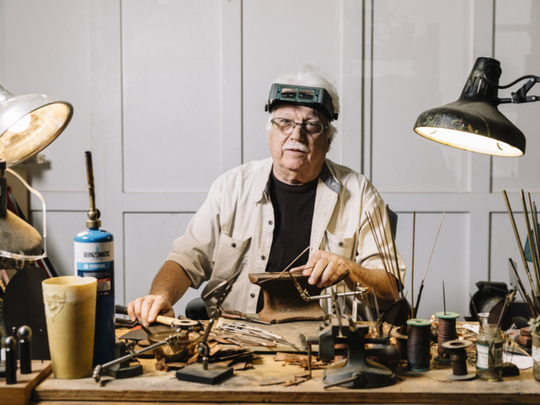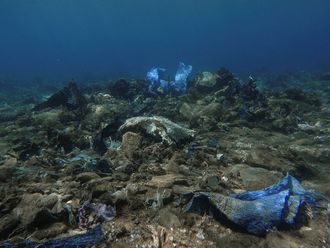
New York: Picture a redwood forest. The trunks like monoliths. The tree canopy like clouds. The fallen needles: a shag rug piled centuries deep.
Now imagine someone has left a broken refrigerator somewhere in the scene. If you were to Instagram this natural tableau, what would your friends identify as the subject of the photo?
An abandoned fridge, right?
A term exists in conservation biology to explain this odd selectivity in how and what we see: “plant blindness.”
The concept, developed 20 years ago by James H. Wandersee and Elisabeth E. Schussler, describes the human tendency to ignore what the two scientists describe as “the aesthetic qualities of plants and their structures.” We habitually overlook such obvious elements as colour, size, spacing, symmetry and tactility that is all around us in natute.
So then, would people notice the majesty of trees if they were, paradoxically, smaller? This is the thought that guides the practice of botanical miniatures: tiny plants sculpted in 3-D.
Replicating a plant in miniature demands a lot of ingenuity. The attempt to fabricate a simple tiny twig or leaf has inspired designers and artists to experiment with anything and everything: polymer clay, wax, wood, glass, copper, paper, vellum, resin, foam, cotton, sponge, feathers, fake fur, artificial crocodile skin and parsley.
Botanical miniatures belong in a cabinet of curiosities: Suddenly, by being scaled down, they invite a level of scrutiny that makes the everyday appear not just unfamiliar but exotic. Occupying the border between science and art places them in the land of design. It’s a small niche, with few practitioners.
And yet the work is making a sizable footprint all across the US: in botanical sanctuaries such as Longue Vue House and Gardens in New Orleans, and Callaway Resort & Gardens in Pine Mountain, Georgia; in museum shows in New York, Miami and Palo Alto, California; and in natural history museums, such as the Wild Center in Tupper Lake, New York.
These curiosities invite us to see plants — their colour, size, spacing, etc. — for the sake of seeing plants. No small feat.
Look this way please
Patrick Jacobs, 46, began his career in sculpture by studying old pest- and weed-control manuals. Next, he recreated the demonstration photos — a cellar floor, an empty sidewalk — as dioramas of dead space. Eventually, Jacobs added the latex rubber cast of a yellow-splotched “broad-leafed plant,” soon to be poisoned into oblivion.
A few decades later, the weeds have won out. (They always do.) The viewer observes Jacobs’ teeming green worlds through a custom-ordered biconcave lens. The diorama may measure just a foot wide by 10 inches tall and deep. Yet objects farther from the lens appear smaller, creating the illusion of great depth. A sealed steel box becomes a sort of holodeck, transporting the visitor to a wide-open meadow.
This bit of enchantment works just as well once you’ve learned the trick. A work like “Field of Dandelions,” for instance, reveals some 300 dandelions overrunning a lawn of grass and clover. But each margarine-colored flower presents a handmade fabrication by Jacobs: an assemblage of vellum, styrene, glue and acrylic paint.
Nature, of course, produces dandelions everywhere, in effortless abundance. With his miniature, Jacobs seems to be exploring just how much labour it takes to get someone to notice.
Stephanie Ratcliffe, 59, the executive director of the museum, said that sculptures like these, in a glass cabinet, could help visitors recognize the plants on a hike in the field. “There’s only so much you can learn in two dimensions — cameras and phones and flat screens,” Ratcliffe said.
Glass plants
The acknowledged masters of botanical sculpture were a father-and-son team, Leopold and Rudolf Blaschka, 19th- and early-20th-century German artisans who created more than 4,000 plants out of glass. (A small part of the collection can be viewed at the Harvard Museum of Natural History, which originally commissioned the work.)
Botanical sculptor Trailer McQuilkin, 71, shares that belief. The only way to render a wildflower with his extreme level of accuracy is to work from a living model. “I take these plants apart and dissect them, and count each stamen,” he said.
After collecting a rare glacier lily from 11,000 feet up in the North Pole Basin of the Colorado Rockies and stashing it in a cooler, McQuilkin will rush home to his studio on the Mississippi Gulf Coast. Then he’ll fabricate the sundry plant forms — the buds, the flower, the calyx — for days on end. If the plant dies first, he needs to return to the alpine meadow to dig up another one. If it’s not in bloom? See you next year.
One business advantage of McQuilkin’s method is that almost no one else would have the patience to try it. In part that comes from his supremely unforgiving material: sheet copper, copper wire and oil paints. For almost 50 years, he’s been employing a tool set that includes shears, surgical scissors, pliers, a rubber mallet, an anvil and a butane torch. (At this autumnal stage in his own life cycle, McQuilkin also relies on jeweler’s glasses.)
He works at life scale, but the plant parts can be minute. To paint the fine veins on a leaf, McQuilkin said, “I’ll take a sable-hair brush and cut it down to two or three hairs.”
Many of the finished pieces go to botanical gardens. “Artists have art critics,” he said. “My critics are botanists.” An even better endorsement comes when a bee or hummingbird dive bombs his copper flowers in search of pollen.
Miniature to bigiature
In recent years, Matthew Albanese, 35, has recreated oaks and willows from his memories and imagination. This Eden turns out to be the northwest corner of New Jersey, where he lives. But for the past few months, Albanese has been studying paleobotany for a diorama called “The Hottest Day on Earth.” The garden includes vanished genera such as Tempskya (a trunkless tree fern of the Cretaceous period) and Sigillaria (a spore-bearing tree of the Late Carboniferous period).
“You may think it’s a normal jungle, but it’s actually quite alien,” Albanese said. “If you look closely, you’ll say, ‘I’ve never seen a tree like that.’”
The plan for the finished model involves hundreds of specimens staged on a plywood platform the size of a Ping-Pong table. “It’s more a bigature than a miniature,” Albanese said.
Willing to travel a little further afield? Albanese has discovered through trial and error that the dust surface of the planet Mars looks like a mixture of cinnamon, chili pepper and paprika. Science-fiction movies were his first love, and his finished art takes the form of highly staged cinematic photographs. Albanese constructs his landscapes as they appear through the lens of his Canon 5D. From this angle, Albanese isn’t just goofing around with dyed feathers and fake fur; he’s building a movie set.
Small in size but big in concpet
Painter Gregory Euclide, 44, has created a go-to list of botanical substitutions. Dried sedum, with its billowing seed head, looks like the archetype of a leafy tree. A single pine-cone scale resembles a shelf mushroom.
Euclide collects a lot of these supplies from around his 6-acre hobby farm in St. Peter, Minnesota. Until a few months ago, his studio was the farm’s derelict milking parlor; patches of 50-year-old cow dung remain bonded to the floor.
Euclide seems to admire the tenacity of the stuff. His paintings explore themes of urban decay, with miniature forests spilling off the canvas. It’s tromp l’oeil crossed with an oil spill.
In some sense, however, the trick to Euclide’s art is that there’s no trick. By working with plants like jasmine flower and sage as modeling materials, “There’s nothing in there that’s not what it is,” Euclide said. “A wolf is an animal even when it’s wearing a sheep’s coat.”
A plant is a plant, no matter how small.












